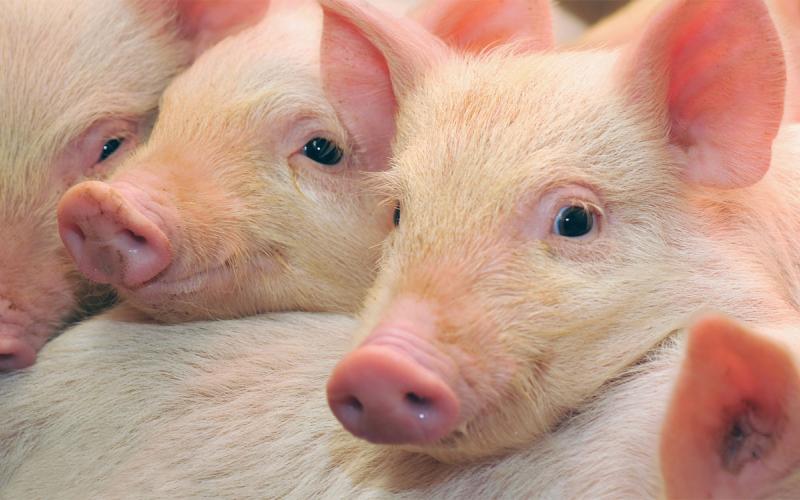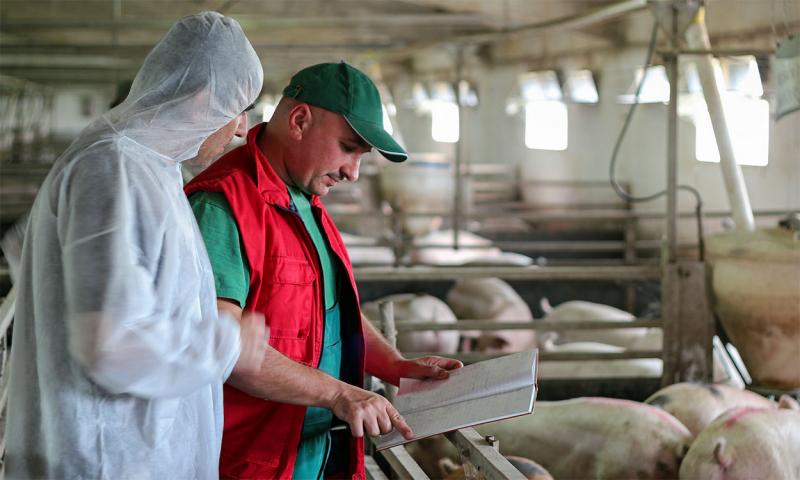
Written collaboratively by Bindu Paudel and Deepthi Kolady. Reviewed by Heather Gessner.
The United States is the second-largest consumer of antibiotics in animal agriculture. The Federal Drug Administration (FDA) restricted the use of all medically important antibiotics for growth promotion in food-producing animals in the United States. Concerns about antibiotic resistance development and its impact on human and animal health, and the overall economy were the reasons behind the restrictions. Further, antibiotics used for disease prevention are now under veterinarians' control through the Veterinary Feed Directive (VFD).
A complete ban on antibiotic use in animal agriculture would increase the costs of livestock production and demand changes in production environments and practices (Brorsen et al. 2002, McBride, Key, and Mathews 2008, Miller et al. 2005, Dee et al. 2018). Dee et al. (2018) highlighted the challenges of raising hogs completely antibiotic-free under a significant disease challenge, such as porcine reproductive and respiratory syndrome virus (PRRSV), and argued for responsible use of antibiotics instead of completely antibiotic-free production systems. Discussions and policy dialogue around the VFD increased consumers' and producers' awareness of antibiotic use in animal agriculture and its potential health and economic impacts.
Given this, livestock producers have the opportunity to differentiate between the use of antibiotics for disease treatment and prevention purposes. However, livestock producers' decisions on antibiotic use in animal agriculture depends on consumer demand.
Thus, we questioned if consumers prefer meat produced with the minimal use of antibiotics compared to meat produced with standard antibiotic use and how this would compare to meat produced without antibiotics. We conducted an online national survey of 660 U.S. consumers in June 2019 to elicit their preferences for pork attributes and examine their willingness to pay (WTP) for pork chops from pigs raised without antibiotics and minimal antibiotic use for disease treatment.
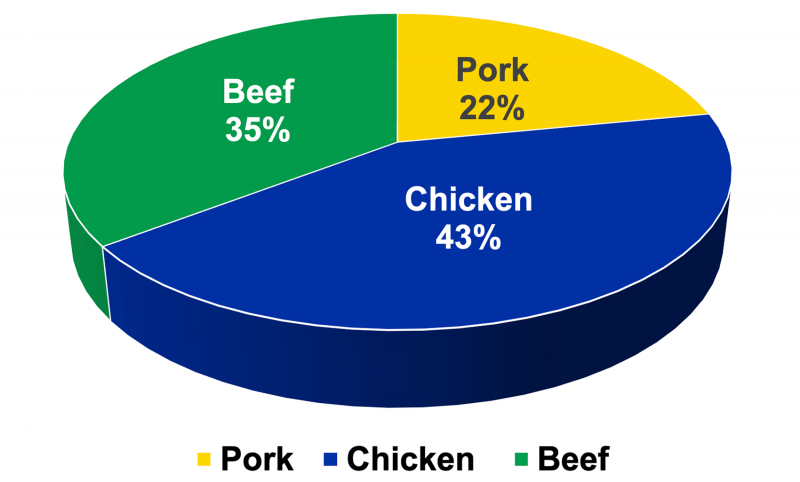
Since the study also sought to examine the influence of information on the level of antibiotic use, we used a split survey design and randomly assigned survey respondents to an information or control treatment. In the information treatment, respondents received information on the non-therapeutic use of antibiotics in pork production, current knowledge of its effect on antibiotic resistance development, and the VFD. Respondents in the control treatment of the survey received no such information. A total of 328 respondents received the control treatment, and 332 respondents received the information treatment. In addition to each respondent's socio-demographic information, we collected meat purchasing behavior, meat consumption pattern, preferences for meat attributes, familiarity with antibiotics use in pork production, and lifestyle attributes.
U.S. consumers' meat preferences and awareness of antibiotic use
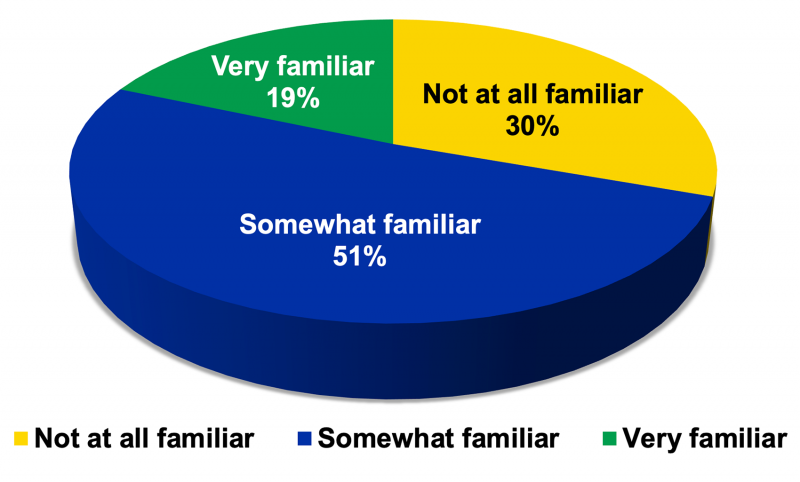
The average meat consumption per individual per week in the sample was 5.35 pounds, of which chicken accounts for 43%, beef 35% and pork 22% (Figure 1).
Since the study focuses on pork consumption, we elicited the importance of various pork attributes in consumers' purchasing decisions. The survey also shows food safety and certification, quality, use of synthetic growth promoter (SGP), and antibiotic use level are important attributes influencing consumers' pork purchasing decisions.
The survey also revealed that 19% of the sample were very familiar with using antibiotics in livestock production, 51% somewhat familiar and 30% not at all familiar (Figure 2). Thus, a relatively high number of individuals are familiar with antibiotic use in livestock production.
U.S. Consumers' preferences and willingness to pay for meat attributes
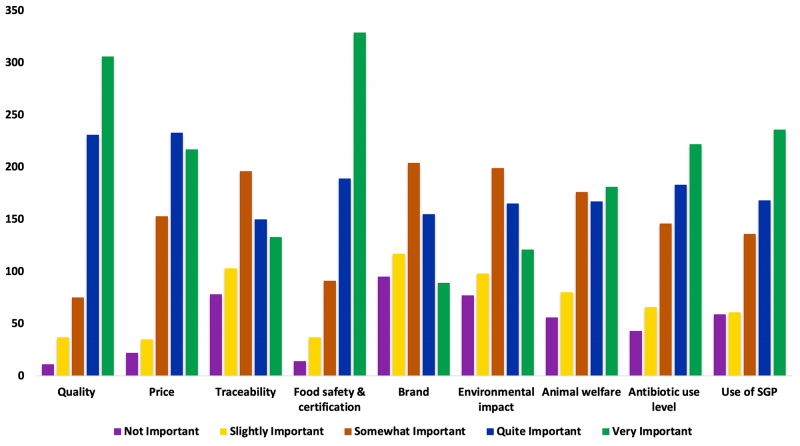
We employed a discrete choice experiment that simulates real-life purchasing situations to estimate consumers' WTP for various pork attributes. Pork attributes and levels included in the discrete choice experiment are outlined in Table 1.
Antibiotic use attributes in the choice experiment represent pork options post-VFD: antibiotic-free (without any antibiotic use), minimal antibiotic use (antibiotic use for disease treatment purpose), conventional antibiotic use (antibiotics for prophylactic purposes), and no information on antibiotic use level. Other production practices associated with antibiotic use level. Our incorporation of additional production attributes (confinement versus pasture-raised and use versus no-use of synthetic growth hormone) reflects it.
| Pork Attributes | Levels |
|---|---|
| Price | $1.99/lb $3.99/lb $5.99/lb $8.99/lb |
| Antibiotic use level | Conventional use of antibiotics Minimal use of antibiotics Antibiotic-free No information |
| Production method | Pasture-raised production method Confinement No information |
| Use of synthetic growth promoter | Yes No No information |
Source: Authors
Consumers in the control and information treatment were willing to pay, on average, 68 cents/pound and 53 cents/pound more, respectively, for pork labeled as conventional use of antibiotics (prophylactic purpose), compared to the no-information option, and $1.05/lb and $1.32/lb more, respectively, for pork chop labeled as minimal use of antibiotics (therapeutic purpose), compared to the no-information option, and $3.05/lb and $3.47/lb, more, respectively, for pork chop labeled as antibiotic-free, compared to the no-information option (Table 2).
| Variable |
(n=328) |
(n=332) |
|---|---|---|
| Conventional use of antibiotics |
|
|
| Minimal use of antibiotics |
|
|
| Antibiotic-free |
|
|
Source: Authors estimation using survey data
Conclusion
The study shows that U.S. consumers are willing to pay a premium for pork chops produced without antibiotics and with minimal antibiotic use for treatment purposes. The study's findings suggest a potential for product differentiation for a pork chop based on antibiotic use level in production. The study results imply that the provision of information on the non-therapeutic use of antibiotics in pork production and its relation to antibiotic resistance development has a positive effect on consumer WTP for meat products with reduced use of antibiotics. The study provides helpful insights for livestock producers to develop production practices and marketing strategies that reduce antibiotic use in animal agriculture without negatively impacting their net incomes.
Acknowledgment: Authors acknowledge the financial support from the South Dakota Agricultural Experiment Station for this study.
References
- Brorsen, B.W., T. Lehenbauer, D. Ji, and J. Connor. 2002. "Economic Impacts of Banning Subtherapeutic Use of Antibiotics in Swine Production." Journal of Agricultural and Applied Economics 34 (3):489-500.
- Dee, Scott, Jose Ezequiel Guzman, Dan Hanson, Noel Garbes, Robert Morrison, Deborah Amodie, and Lucina Galina Pantoja. 2018. "A randomized controlled trial to evaluate performance of pigs raised in antibiotic-free or conventional production systems following challenge with porcine reproductive and respiratory syndrome virus." PLOS ONE 13 (12):e0208430. doi: 10.1371/journal.pone.0208430.
- McBride, W., N. Key, and K.H. Mathews. 2008. "Subtherapeutic Antibiotics and Productivity in U.S. Hog Production." Applied Economic Perspectives and Policy 30 (2):270-288.
- Miller, G.Y., X. L. Liu, P.E. McNamara, and E.J. Bush. 2005. "Farm-Level impacts of banning growth-promoting antibiotic use in U.S. pig grower/finisher operations." Journal of Agribusiness 23 (2):1-16.
